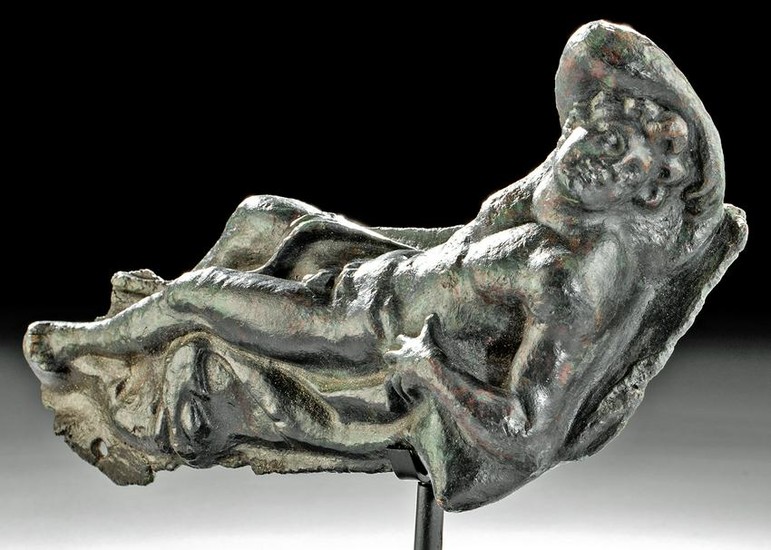Published Roman Bronze Applique - Reclining Bacchus
Roman, early Imperial Period, ca. 1st to 2nd century CE. An intricate cast-bronze applique that is formed via the lost wax (cire perdue) process depicting Bacchus (Greek Dionysus or Dionysos), the god of wine, pleasure, ritual madness, ecstasy, and theater. Bacchus presents nude while reclining in a languid pose atop a luxurious panther skin with recognizable feline claws near his knees. His torso turns slightly to the left and is supported by his bent left arm, and his right arm is draped leisurely atop his coiffure of thick, curling locks. Bacchus' handsome countenance features almond-shaped eyes beneath puffy lids, a broad nose above full lips, and a rounded chin flanked by puffy cheeks. The top plateaued periphery was meant to be placed along the outer edge of a chariot or chest, and a petite fastener hole is perforated near one lower corner. Lustrous layers of mottled russet, brown, and green patina cover every surface of this exquisitely crafted applique. Size: 8" L x 4.25" W (20.3 cm x 10.8 cm); 6.1" H (15.5 cm) on included custom stand.
Bacchus (Greek Dionysos or Dionysus) was the great Roman god of wine, vegetation, pleasure, and festivity, and was the deity to which the Romans dedicated their festival of drunken revelry known as Bacchanalia. Though a prominent subject in Roman art, he was not always depicted in the same manner. The Romans typically characterized him as an elderly man with a lengthy beard or an attractive, effeminate, long-haired youth as we see in this example. His attributes typically included the thyrsus (a long staff topped with a pinecone), a drinking cup, a leopard or panther skin like in this example, and a fruiting vine, and he was usually accompanied by a troop of Satyrs and Maenads.
Published in: Eisenberg, Jerome. "Art of the Ancient World." vol. XXI (2010), no. 55; vol. XXVII (2016)
Provenance: private New York, New York, USA collection, acquired in 2008 from R. Goetze; ex-private R.G. collection, Calodyne, Mauritius, acquired between 1977 and 1985; ex-Leo Mildenberg collection
All items legal to buy/sell under U.S. Statute covering cultural patrimony Code 2600, CHAPTER 14, and are guaranteed to be as described or your money back.
A Certificate of Authenticity will accompany all winning bids.
We ship worldwide to most countries and handle all shipping in-house for your convenience.
#152683 Dimensions: Condition Report: Losses to areas of peripheries and verso as shown. Minor abrasions to legs, arms, body, peripheries, and verso, with softening to some finer details, light encrustations, and slight bending to some peripheral areas. Nice earthen deposits and great patina throughout.
View it on
Estimate
Time, Location
Auction House
Roman, early Imperial Period, ca. 1st to 2nd century CE. An intricate cast-bronze applique that is formed via the lost wax (cire perdue) process depicting Bacchus (Greek Dionysus or Dionysos), the god of wine, pleasure, ritual madness, ecstasy, and theater. Bacchus presents nude while reclining in a languid pose atop a luxurious panther skin with recognizable feline claws near his knees. His torso turns slightly to the left and is supported by his bent left arm, and his right arm is draped leisurely atop his coiffure of thick, curling locks. Bacchus' handsome countenance features almond-shaped eyes beneath puffy lids, a broad nose above full lips, and a rounded chin flanked by puffy cheeks. The top plateaued periphery was meant to be placed along the outer edge of a chariot or chest, and a petite fastener hole is perforated near one lower corner. Lustrous layers of mottled russet, brown, and green patina cover every surface of this exquisitely crafted applique. Size: 8" L x 4.25" W (20.3 cm x 10.8 cm); 6.1" H (15.5 cm) on included custom stand.
Bacchus (Greek Dionysos or Dionysus) was the great Roman god of wine, vegetation, pleasure, and festivity, and was the deity to which the Romans dedicated their festival of drunken revelry known as Bacchanalia. Though a prominent subject in Roman art, he was not always depicted in the same manner. The Romans typically characterized him as an elderly man with a lengthy beard or an attractive, effeminate, long-haired youth as we see in this example. His attributes typically included the thyrsus (a long staff topped with a pinecone), a drinking cup, a leopard or panther skin like in this example, and a fruiting vine, and he was usually accompanied by a troop of Satyrs and Maenads.
Published in: Eisenberg, Jerome. "Art of the Ancient World." vol. XXI (2010), no. 55; vol. XXVII (2016)
Provenance: private New York, New York, USA collection, acquired in 2008 from R. Goetze; ex-private R.G. collection, Calodyne, Mauritius, acquired between 1977 and 1985; ex-Leo Mildenberg collection
All items legal to buy/sell under U.S. Statute covering cultural patrimony Code 2600, CHAPTER 14, and are guaranteed to be as described or your money back.
A Certificate of Authenticity will accompany all winning bids.
We ship worldwide to most countries and handle all shipping in-house for your convenience.
#152683 Dimensions: Condition Report: Losses to areas of peripheries and verso as shown. Minor abrasions to legs, arms, body, peripheries, and verso, with softening to some finer details, light encrustations, and slight bending to some peripheral areas. Nice earthen deposits and great patina throughout.



